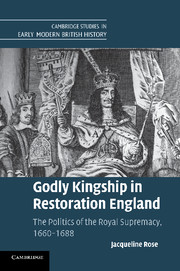Book contents
- Frontmatter
- Contents
- Acknowledgements
- Abbreviations and conventions
- Introduction The Restoration, the Reformation, and the royal supremacy
- Chapter 1 Foundations and legacies: the Reformation and the royal supremacies, 1530–1660
- Chapter 2 The crown and the cavalier Anglicans: prerogative, parliament, and ecclesiastical law
- Chapter 3 Spiritual authority and royal jurisdiction: the question of bishops
- Chapter 4 Dissenters and the supremacy: the question of toleration
- Chapter 5 Anticlericals and ‘Erastians’: the spectre of Hobbes
- Chapter 6 Catholics and Anglicans: James II and Catholic supremacy
- Conclusion
- Bibliography
- Index
Introduction - The Restoration, the Reformation, and the royal supremacy
Published online by Cambridge University Press: 05 July 2011
- Frontmatter
- Contents
- Acknowledgements
- Abbreviations and conventions
- Introduction The Restoration, the Reformation, and the royal supremacy
- Chapter 1 Foundations and legacies: the Reformation and the royal supremacies, 1530–1660
- Chapter 2 The crown and the cavalier Anglicans: prerogative, parliament, and ecclesiastical law
- Chapter 3 Spiritual authority and royal jurisdiction: the question of bishops
- Chapter 4 Dissenters and the supremacy: the question of toleration
- Chapter 5 Anticlericals and ‘Erastians’: the spectre of Hobbes
- Chapter 6 Catholics and Anglicans: James II and Catholic supremacy
- Conclusion
- Bibliography
- Index
Summary
The idea of the godly magistrate was common parlance in Restoration England. The depiction of Charles II on the frontispiece of William Prynne’s An Exact Chronological Vindication and Historical Demonstration of our British, Roman, Saxon, Danish, Norman, English Kings Supreme Ecclesiastical Jurisdiction of 1666 (see plate 1, opposite) was an exemplary illustration of the godly ruler. The Church quite literally rests on the royal sword, around which are entwined the words ‘Carol[us] D[ei] G[ratia] fidei et ecclesiae defensor’: Charles by the grace of God defender of the faith and church. Power flows from a heavenly hand to Charles, who wears a closed imperial crown, symbol of his Constantinian sovereignty. And above the church is a banner referring to Isaiah 49:23, the proof-text for royal supremacy: ‘kings shall be thy nursing fathers, and their queens thy nursing mothers’. This reflected a widespread language of godly kingship in Restoration England. This book provides the first account of the significance of this rhetoric.
- Type
- Chapter
- Information
- Godly Kingship in Restoration EnglandThe Politics of The Royal Supremacy, 1660–1688, pp. 1 - 25Publisher: Cambridge University PressPrint publication year: 2011

